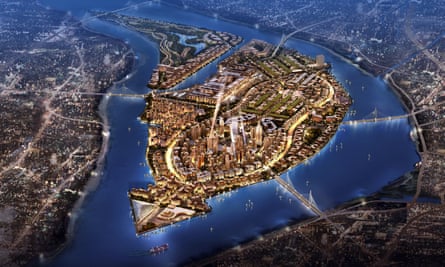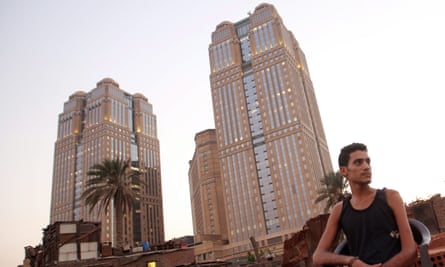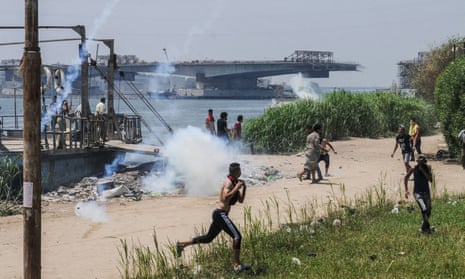Heba Nagaa Otmorsi was at work when a relative called to say her house had been demolished. That day she had boarded a ferry from Cairo’s Warraq Island to the mainland, unaware her home was under threat.
Most families had been asleep when government forces arrived early in the morning in armoured cars. “It was our neighbours who rescued the children,” says Otmorsi. “The government said [residents] had Molotov [cocktails] and weapons. They arrested anyone who confronted them.”
Almost overnight, Warraq Island went from a lush if impoverished oasis in the centre of the Nile river to the site of a fierce battle between residents and the local Giza authorities over plans to build a new bridge – and potentially remodel the entire island itself.
The clashes last weekend left one 23-year-old protester dead and a further 19 injured after police fired tear gas to disperse huge crowds protesting against the government’s incursion.
The island, a teardrop-shaped verdant sprawl of fields, unpaved roads and squat redbrick houses, is home to roughly 90,000 people and connects to the rest of the capital by ferries, transporting residents to the nearby districts of Warraq or Shobra al Kheima on the banks of the Nile.
The new bridge will ostensibly form part of the Rod El Farrag project, designed to connect parts of central Cairo to its outlying suburbs. Yet two proposals previously submitted show that the government has considered a far larger transformation for Warraq Island, with the bridge simply the first stage of a plan to treat the land as prime real estate.

Egyptian architectural firm Cube Consultants submitted a “conceptual masterplan” proposal to the General Organisation for Physical Planning in 2010 to transform Warraq Island into “Horus Island”, complete with glossy towers, wide boulevards and a marina. The project was considered as part of Cairo 2050, a sweeping transformation plan by the former regime of Hosni Mubarak that was criticised for its potential to make millions of the city’s poorest residents homeless.
While Cairo 2050 faded into the dust with the end of the Mubarak regime in 2011, plans to radically reinvent central Cairo continue to have the ear of the Egyptian authorities. A second proposal submitted in March 2013 from Singaporean architectural firm RSP was also considered, but never came to fruition. Its vision saw Warraq Island boast a glass skyscraper, a glistening glass pyramid, and manicured riverside walkways.
After news reports of tension on Warraq Island emerged, RSP reportedly removed its design for the island from its website. It later told reporters that “the company is no longer related to the project, after the design was completed at the request of a customer”. The company has not responded to a request for comment.
A further 150 demolitions are still planned on Warraq Island, according to local newspaper Al Shorouk. Explanations from the Egyptian authorities range from claims of a lack of proper sanitation to suggestions that the island is in fact a nature reserve. However, in local reports following Sunday’s protests, the prime minister, Sherif Ismail, repeated the accusation that residents are squatting illegally on state-owned land.
Otmorsi and neighbouring families are now sleeping on blankets salvaged from their demolished houses, taking shelter under the jutting grey concrete beams of the unfinished bridge.
At first, fellow resident Hanaa Abdel Aad says the islanders were thrilled that a lifeline to the city was being built. “When they started building [it], local residents helped them. We brought the construction workers tea and water.” But support quickly faded when the government began demolishing their homes, she says.

For Warraq Island residents, the bridge now symbolises a threat to the whole island, the first step in a plan to transform it into an opulent but exclusive residential area.
“We don’t want compensation. We want our houses to be rebuilt,” insists Otmorsi. Like all of the families now living underneath the bridge, she brandishes a collection of documents that she says prove ownership of the house she bought in 2004. Her sister, who declined to be named, pointed to a stamp from Egypt’s ministry of justice on her housing contract. “So what’s this then?” she asks.
Demolishing the homes of impoverished Cairo residents to make way for redevelopment plans is not new. Further down the Nile, the Maspero Triangle redevelopment project could displace 41,000 local residents to make way for a collection of high-rises and glossy buildings designed by Norman Foster. Residents have reportedly been promised replacement housing in Egypt’s desert suburbs, but say this is an unworkable solution that would cast them far away from their jobs and families. Elsewhere, the Nile City Towers development shimmers as it overlooks the surrounding Bulaq neighbourhood, welcoming visitors to a five-star hotel, a cinema and a mall that few of the working-class residents can access. In 2012, the towers were attacked by locals, resulting in one death.

“They want to remove us, so a rich investor can come to build skyscrapers and malls,” said one island resident, who declined to be named for fear of government reprisals. “If you want to develop this place, shouldn’t you provide us with better services? Or should you remove us? I don’t want you to develop my house, I am fine with its status. Just get me water and electricity. And let me be.”
The deputy Giza governor, Alaa al-Haras, who oversees Waraq Island, told local news outlets that the authorities will meet with residents to discuss the situation, but reportedly warned that “just because we will meet, doesn’t mean that we’re scared, or that we won’t proceed [with the demolition]”. When contacted by the Guardian, Al-Haras declined to comment.
Deen Sharp, who works at the Centre for Advanced Urban Research, said the situation on the island demonstrates how, “like many states around the world, the Egyptian government is focused on constructing its cities around the needs of financial capital and the powerful rather than those of its citizens”.
One week on, the residents of Warraq Island are continuing to protest, a rare confrontation between citizens and the Egyptian state since unauthorised street protests were banned in November 2013. “The people know for sure that there will be a stab in the back from the government. We hear the officials saying that they will continue the demolition no matter what,” said Mahmoud Mohamed, a student who lives on Warraq Island.
For Otmorsi, there is nothing left to lose now that she and her entire extended family of 18 are homeless. “Is this what [President Abdel-Fatah] al-Sisi wants? What will happen to our kids? We accepted the rising prices, and the oppression…” she said, her speech trailing off as she wonders what will come next for the island.
Follow Guardian Cities on Twitter and Facebook to join the discussion, and explore our archive here
